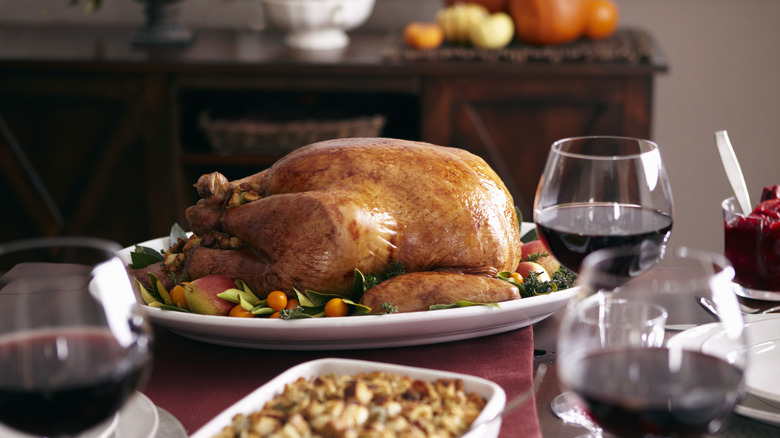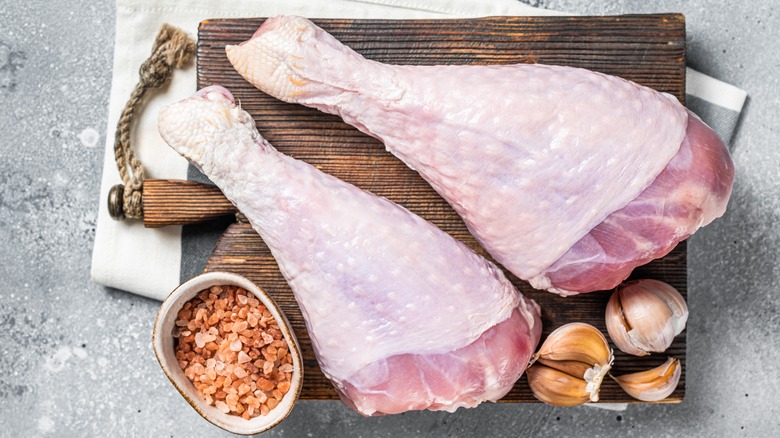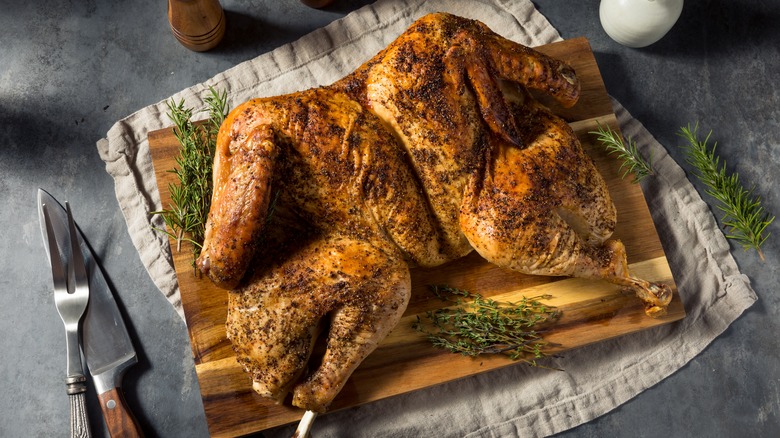The Worst Way To Cook A Turkey Is One Of The Most Popular
Cook a turkey whole and you often end up with parts of it that are just right while other parts, usually the legs, are raw. The uneven cook arises from the temperatures required to cook white meat versus dark meat — or breast meat versus leg meat, respectively. The dark meat requires temperatures of at least 165 degrees Fahrenheit to cook, while the white meat starts to get dry past about 145 degrees Fahrenheit.
Much of the challenge that comes from cooking the turkey whole arises from the mechanics of the bird's legs in relation to its body. The legs are shielded by connective tissue and the body itself, which is why the thighs and legs usually need to cook longer. The breast, on the other hand, has no such protections when it's still attached to the whole bird. It also sits directly over the oven's heat grills. In fact, it's the very position of the breast and its fat composition, or lack thereof, that propels its quick cooking times. (And the excessive drying of the breast meat if you're not careful, though you can moisten the dried turkey meat with gravy once dinner's ready.)
In short, cooking the bird whole does nothing to mitigate these issues. However, cooking it in pieces solves the problem, because you can adjust the cooking times and temperatures to each type of meat. In other words, the breast would cook differently than the legs and thighs do, resulting in a perfectly done turkey.
Cooking the bird in parts
If you'd like to cook the bird in pieces, here's what you need to do. Start by cutting the tips off both of the wings, then remove the thighs and legs on both sides of the bird. If you want big pieces of meat, leave the thighs and legs connected. If not, cut those apart as well so that you have two thighs and two legs. Set all of these pieces aside. The two sides of the breast come next. Slice those so that they separate from the backbone. The wings follow the breast. (It's easier to cut the wings off the bird once the breast pieces are no longer attached to the turkey's spine.)
Once these tasks are done, the bird should be completely cut apart. From there, you'll either bag the broken-down turkey in plastic to refrigerate or freeze for later. Once it's time to cook it, you can butter the turkey parts and season them according to your favorite basic roasted turkey recipe before popping them into a roasting pan to cook in the oven. It should take about two hours, plus regular basting, to roast the separated turkey parts. For reference, that's about the same amount of time it takes to cook a 6 or 7-pound turkey.
You could also try spatchcocking the bird
The spatchcocking technique lies somewhere between cooking a whole bird and roasting it in parts. It's a common roasting method among many home chefs who cook chickens and other poultry whole. If you're using this approach, start by cutting out the bird's backbone with a pair of scissors. After you've done this, look to see if there's a hood of fat in the neck area. If so, remove that as well. The bird will be split down the middle if you've removed the backbone correctly.
After that, turn the bird over and pull the legs as far apart as they can go. If you're thinking that this sounds like some sort of ancient Medieval torture technique, you've got the right idea. The legs will be butterflied out in unnatural positions once the backbone is removed. Next, give the turkey's breast a good push until you hear the bones crack. The turkey should appear relatively flat at this point. Once all of this is done, spread the bird out on a baking sheet to cook and season it as usual.
This method works well, because it takes away the structural elements that make turkeys cook unevenly. The legs no longer hug the breast meat. The white meat and the dark meat both sit at about the same distance from the oven's heat grills. Altogether, this creates a more even cook. As a bonus, while the bird doesn't exactly look like something out of a Norman Rockwell painting when you spatchcock it, it does bear a closer resemblance to the Rockwellian ideal than a butchered bird.


